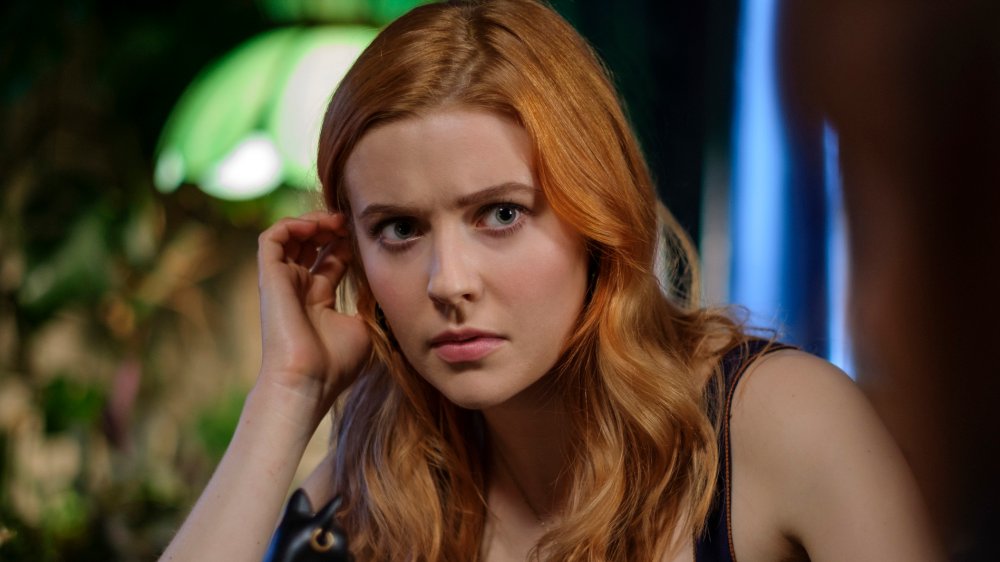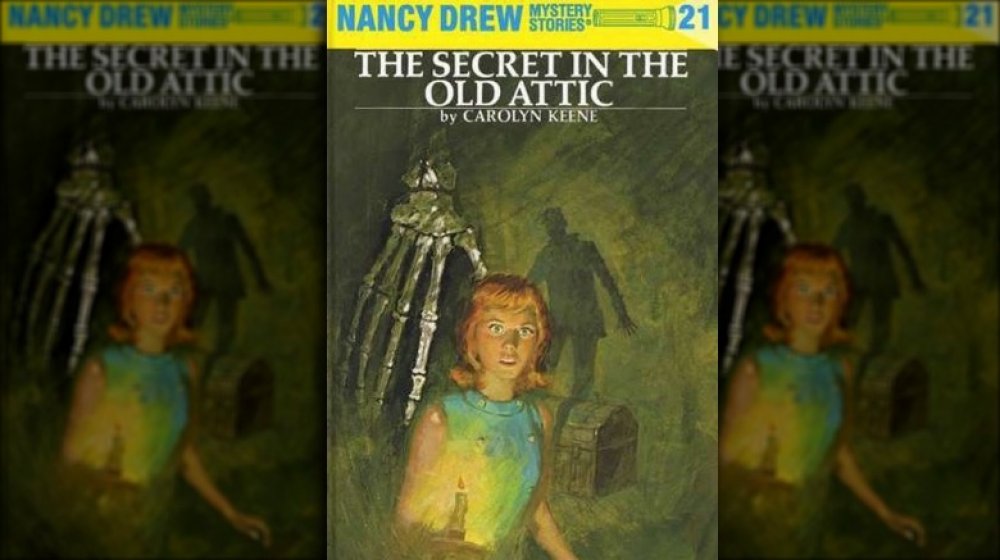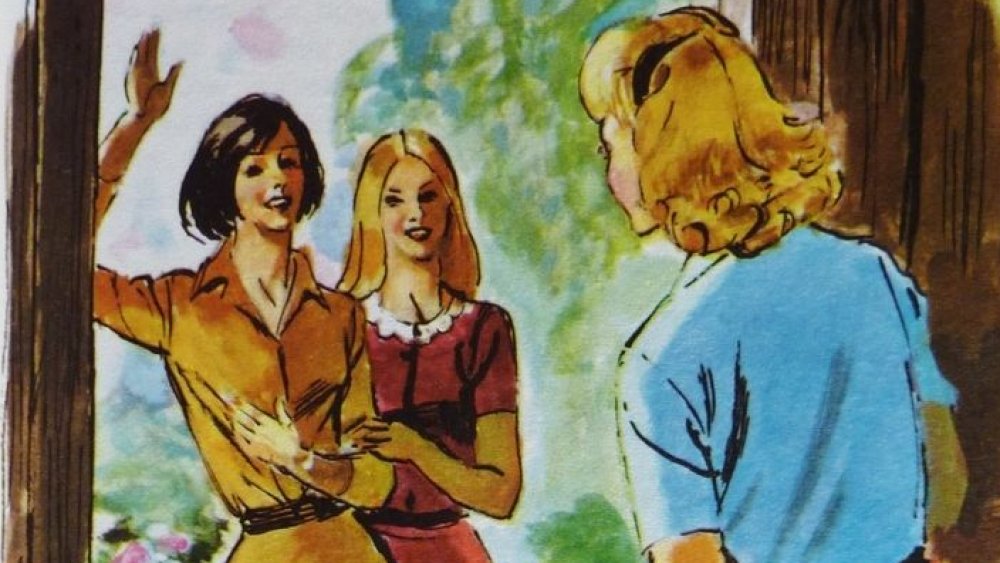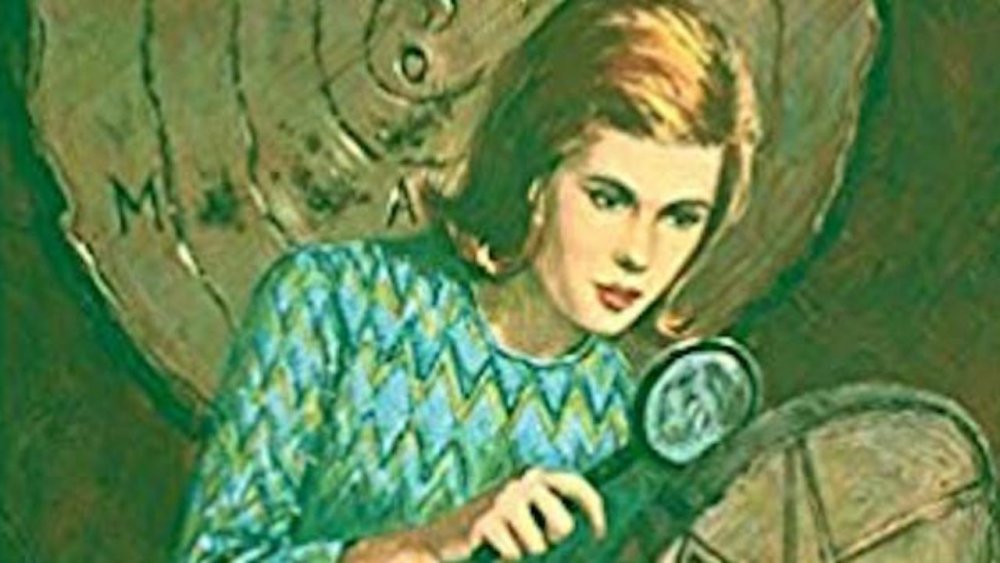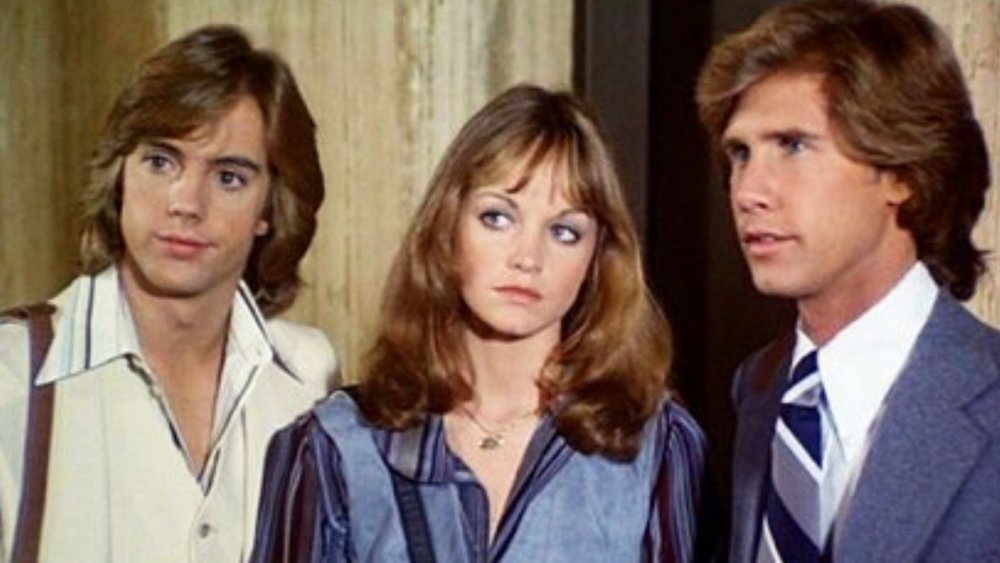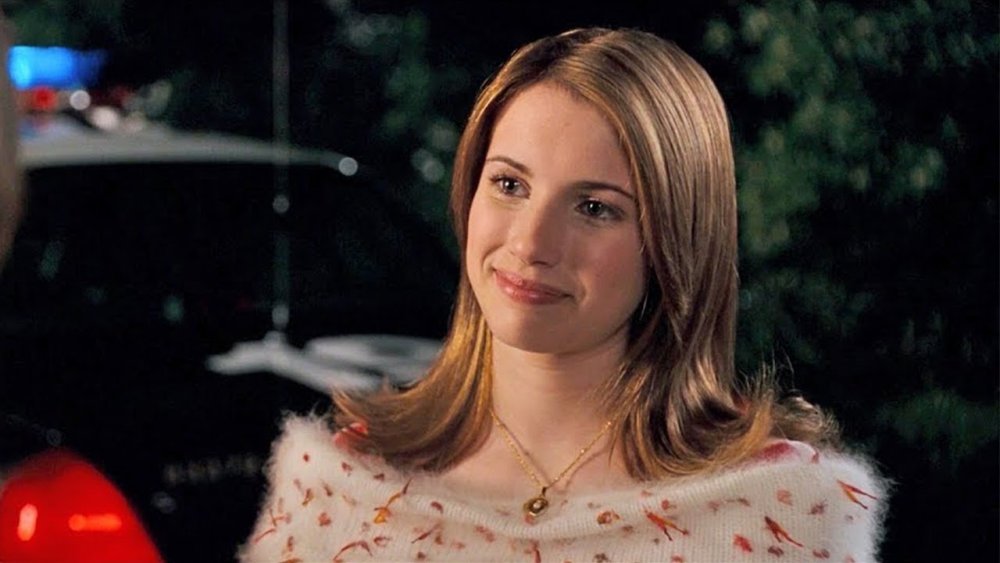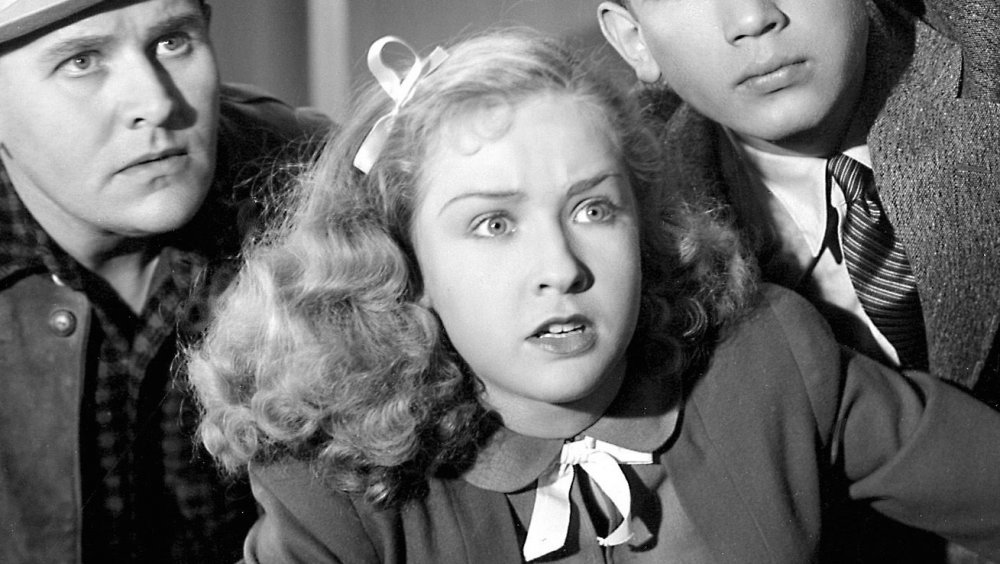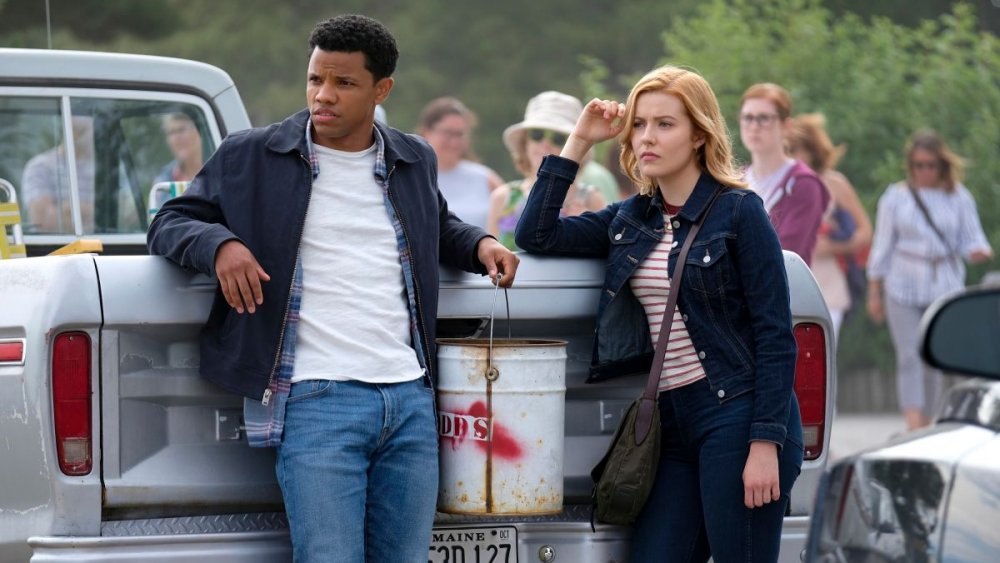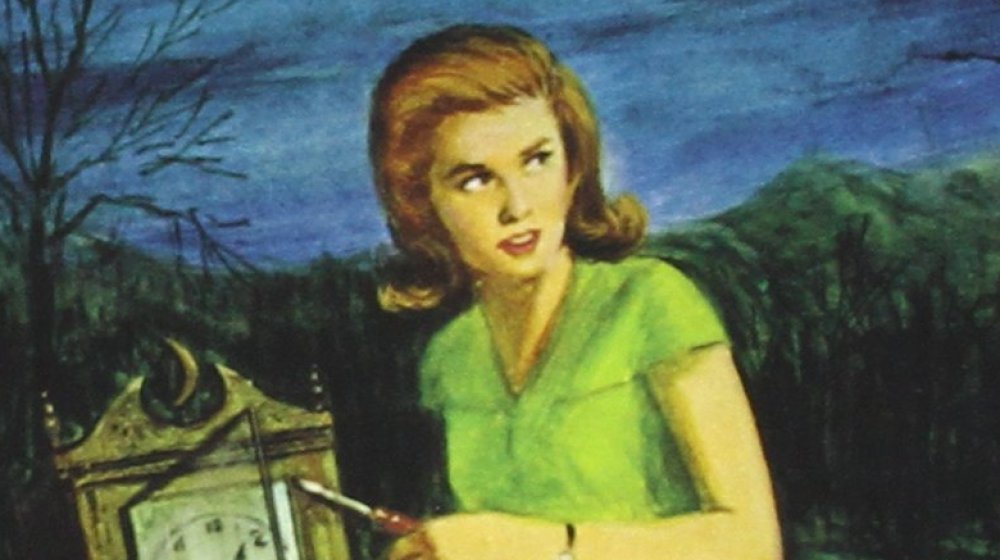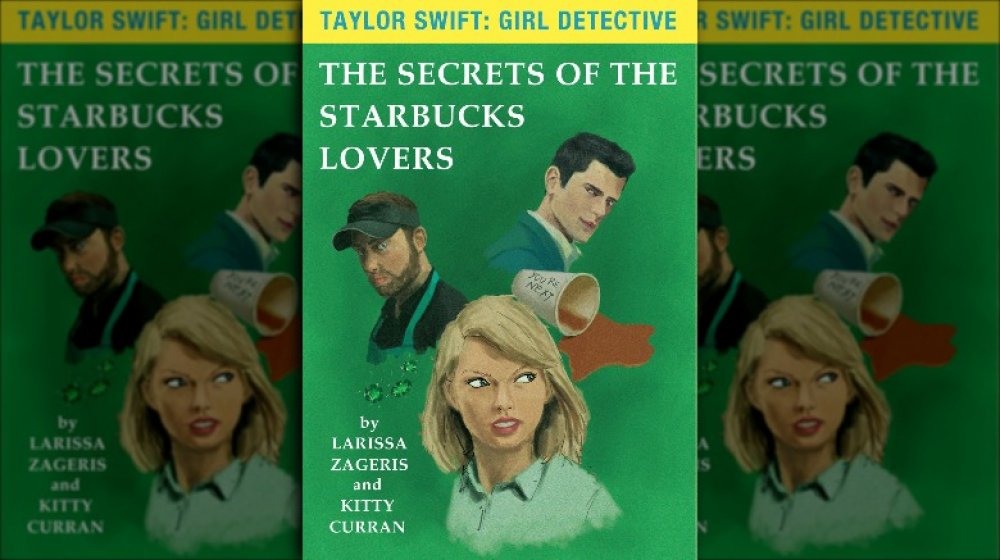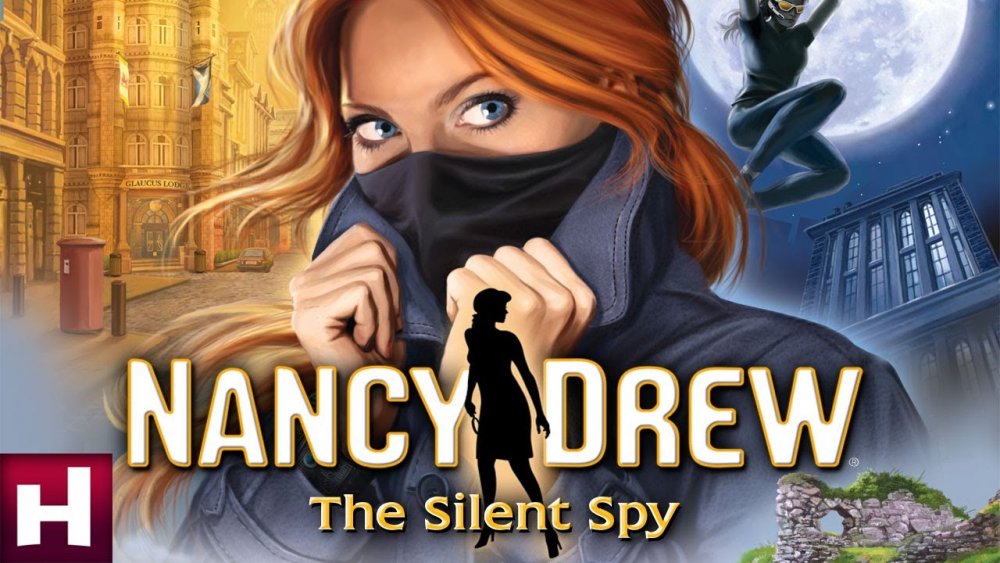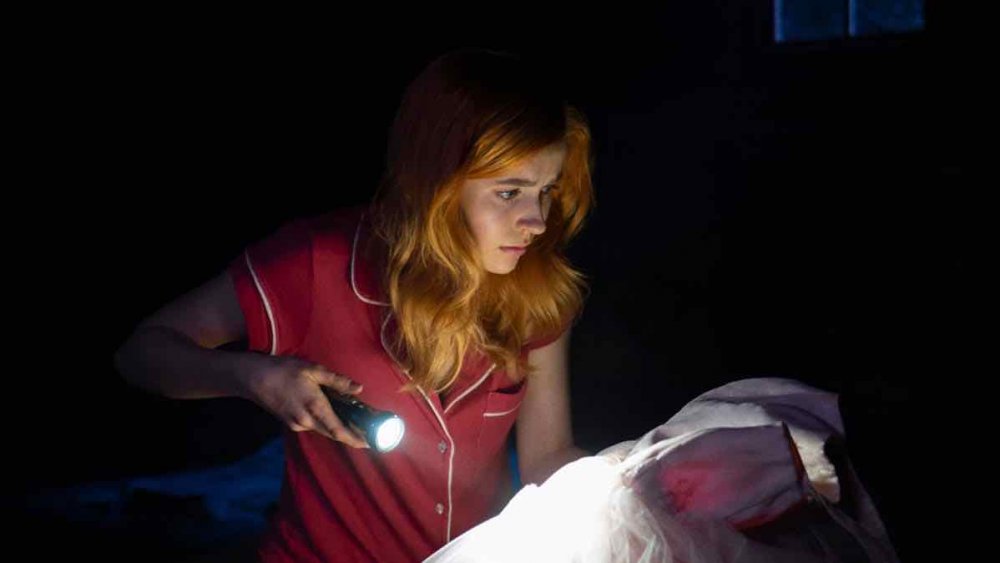The Untold Truth Of Nancy Drew
There are probably only three detectives — who originated in books but came to be featured in all kinds of media — that are household names: Sherlock Holmes, Hercule Poirot, and Nancy Drew. The first two are stodgy old guys invented by British writers. The third is a teenager (usually) and one of the most dynamic, progressive, and inspiring characters in American literature, let alone literature written for young readers.
More than 80 million copies of books have sold featuring the intrepid teenage detective who has the smarts, skills, and solutions to get out of any scrape she finds herself in, all while sleuthing around to solve mysteries of old clocks, hidden staircases, letters, and lockets. River Heights' most famous, blue roadster-driving resident has been part of American culture for 90 years now, appearing in multiple book series, movies, games, and TV shows, including the CW's spooky new series. But of course, there's more to this character than meets the eye, so let's uncover the secret history of the plucky, self-reliant, and unstoppable Nancy Drew.
Nancy Drew and the mystery of Carolyn Keene
Nancy Drew books have historically been credited to author Carolyn Keene, a woman who never existed. In the early 20th century, children's book writer Edward Stratemeyer formed the Stratemeyer Syndicate, through which he developed formulaic mystery adventure series for kids that were pure entertainment with a little dash of moralizing or educational value. The Syndicate produced more than 1,200 books in 125 series, including characters such as the Bobbsey Twins, the Rover Boys, Tom Swift, and the Hardy Boys. Stratemeyer couldn't write all those himself, so he hired ghostwriters who'd receive a flat fee for their work, with the Syndicate retaining all rights and royalties.
Having had major success with Hardy Boys books, Stratemeyer aimed to create a similar series for young female readers. According to Melanie Rehak's Girl Sleuth: Nancy Drew and the Women Who Created Her (via NPR), he sent a memo outlining the basic premise of what would become Nancy Drew, along with summaries of five books, to his publisher, Grosset & Dunlap, in September 1929. The company said yes and had the first Nancy Drew books in stores just seven months later in April 1930. Of the first 30 Nancy Drew books, Toledo Blade reporter Mildred Wirt Benson wrote 23, including the first one, The Secret of the Old Clock. The Stratemeyer Syndicate would then routinely send her detailed outlines of plots, leaving it up to Benson to flesh out everything. For her efforts she received $125 per book, plus a Christmas bonus.
The siblings who kept Nancy Drew going
Edward Stratemeyer gave life to literature's most famous teenager just before his 67th birthday. Books featuring his final and probably best known creation became widely available on April 28, 1930 ... and Stratemeyer died just 12 days later.
According to Melanie Rehak's Girl Sleuth: Nancy Drew and the Women Who Created Her (via HuffPost), the book magnate had drawn up plans for his daughters, Harriet Adams and Edna Squier, to sell the Stratemeyer Syndicate upon his death for what he thought would be the fair price of $500 million. But after the stock market crash of 1929 left the economy in ruins and with the prospect of selling the company at a profit no longer a certainty, Adams and Squier decided to keep the company alive and take it over, moving the office from Manhattan to the home they shared in New Jersey, where the Wellesley-educated Adams had been secretly working as an editor for Stratemeyer titles for years.
Together, Adams and Squier kept the Nancy Drew series alive via their father's method of production — writing an outline and sending it off to a ghostwriter. However, they were a bit more hands-on than their dad, and it was those two who created many familiar elements of the Nancy Drew-niverse, including friends George Marvin and Bess Faye, as well as squeaky clean love interest Ned Nickerson.
She wasn't always so wholesome
The original Nancy Drew books — with the iconic yellow covers — officially fall under the "Nancy Drew Mystery Stories" umbrella. The first four entries hit bookstores in 1930, with 16 published by the end of the decade. But before long, the series felt extremely dated. In 1959, according to Tablet, publisher Grosset & Dunlap asked the Stratemeyer Syndicate to revise the earliest 34 books in the series. The storytelling style had grown antiquated, and the publisher figured a new generation would buy and enjoy the older titles if the dialogue were modernized and the plots condensed, shortening the book from more than 200 pages down to a brisk (and cheaper to print) 180. "A lot of the descriptive elements got lost. Subplots were dropped. A lot of people feel that the spice was lost," Nancy Drew expert Jennifer Fisher told Tablet.
So that's the bad news. As for the good news, the revised Nancy Drew books didn't include the originals' casual and pervasive racism and stereotyping. For example, an African-American caretaker in The Secret of the Old Clock spoke in a cringey dialect and was so lazy (and had "a certain alcoholic glitter in his eyes") that it led to a robbery. Criminals throughout the books were almost always described as having dark skin, while a character in one title was implied to be Jewish and was crudely described as "miserly" and having a "hook nose."
The mystery of why Nancy Drew failed on TV
Despite selling millions of books to multiple generations of readers, Nancy Drew has struggled to get noticed on television. After an attempt by Lucille Ball's production company in the 1950s fell through, Nancy hit TV for the first time in 1977 with The Hardy Boys / Nancy Drew Mysteries. Paired up with the Stratemeyer Syndicate's other successful and enduring characters, the series featured Nancy (Pamela Sue Martin, then Janet Julian) solving a mystery one week, and Frank and Joe Hardy (Parker Stevenson and Shaun Cassidy) doing their thing on alternating weeks. Parker Stevenson and Shaun Cassidy became such popular teen idols, however, that producers moved to a format with Nancy and Hardy Boys investigating together before getting rid of Nancy altogether by the show's third and final season.
A couple of years later, the syndicated 1995 Nancy Drew series, which saw the protagonist (Tracy Ryan) as a college criminology student, lasted just 13 episodes, while a 2002 college-set Nancy Drew TV movie that filmed as a pilot wasn't picked up to be a full series. But hey, those attempts at least ended upon on TV. The 2016 CBS project Drew (with Sarah Shahi) didn't even make it because programmers didn't think it would appeal to the network's significantly male audience, and a 2017 version for NBC didn't go anywhere. Here's hoping the CW's 2019 series starring Kennedy McMann fares a bit better.
Her faded film franchise
Undeterred by the lack of interest in previous live-action Nancy Drew projects, Warner Bros. released another franchise-restarting project in 2007, the big-screen Nancy Drew starring a post-Unfabulous, pre-American Horror Story Emma Roberts as the titular crackerjack detective. Written and directed by teen movie veteran Andrew Fleming (Dick, The Craft), the film saw Nancy move to a new town, win over the jaded youths with her old-fashioned ways, and solve the cold case murder of a Hollywood starlet.
Even before the film hit theaters, Warner Bros. announced that it was onboard for a sequel, plans which seemingly fell apart after Nancy Drew earned a mediocre $25 million at the summer box office. A decade later, Warner Bros. went for the reboot instead, releasing Nancy Drew and the Hidden Staircase in 2019 starring It and I Am Not Okay With This star Sophia Lillis as you-know-who. This franchise attempt is likely dead in the water, as it earned a paltry $623,000 in theaters.
The forgotten films of Nancy Drew
While a couple of post-2000 attempts at a Nancy Drew film franchise have been met with middling response, and producers have struggled to get a TV series on the air, the teen detective's exploits were once a frequent and well-received presence on screens. In the pre-TV days of the entertainment industry, popular movie franchises would turn out a couple big-screen entries every year or so, and Nancy Drew was one of them.
In 1938 and 1939, no less than four Nancy Drew movies played to American neighborhood movie houses. Former child star Bonita Granville — who received an Academy Award nomination at age 13 for These Three — took on the title role, first in Nancy Drew: Detective. In this film, Nancy has to pose as a widow in order to help solve the fairly shocking crime of an old woman's kidnapping. Next up, there's Nancy Drew ...Reporter, which finds the protagonist working in an amateur journalism contest, and she winds up clearing a woman of murder charges. Two more films followed, with Nancy Drew ... Trouble Shooter and finally Nancy Drew and the Hidden Staircase, based on the first ever Nancy Drew novel.
The case of the not-so-necessary Ned
Nancy's sort-of boyfriend Ned Nickerson is a near constant presence throughout the various Nancy Drew books and assorted media. And by "sort-of," we mean that the two were definitely an item who had eyes for one another, but they rarely outwardly flirted or kissed because that would've been untoward for a children's novel in the 1930s. But Ned was a good guy — pleasant, nice, secure, and always understanding that Nancy's pursuit of sleuthing came first in her life.
And yet on at least two occasions, Ned Nickerson, just as innocent and square as Nancy Drew, has struggled to say a part of the franchise. For example, in the 1930s Nancy Drew film series, "Ned Nickerson" was replaced with "Ted Nickerson," and Nancy treated him as an annoyance more than an ally. But at least he made it into those films in some form because in the '90s, he was excised from the novels completely. In the 1995 college-set Nancy Drew on Campus book series, readers were invited to call in to vote on how Nancy should direct her romantic affections. Readers elected for Nancy and Ned to split up so that she could pursue in favor of some college hunk named Jake.
The story behind Nancy Drew's name
"Nancy Drew" is the perfect name for a headstrong young detective — otherwise creators wouldn't have picked it, of course. However, the super sleuth almost wound up with a completely different moniker. According to Melanie Rehak's Girl Sleuth: Nancy Drew and the Women Who Created Her (via NPR), in the original paperwork for the project (which proposed a "new series for girls verging on novels" to run 224 pages each), Edward Stratemeyer suggested an umbrella title of "Stella Strong Stories," if not "Diana Drew Stories," "Diana Dare Stories," "Nan Nelson Stories," "Helen Hale Stories," or "Nan Drew Stories."
Well, he almost got it right. They eventually took the diminutive Nan and extended it back into the more timeless Nancy, paired it with the quick, single-syllabic Drew, and they were in business. And after Nancy Drew got her name, lots of other American girls did, too. According to Nameberry, Nancy was one of the most popular girls names from 1931 to 1962, peaking in 1940 when 20,000 newborns were bestowed with it. The rise of Nancy as a name occurred concurrently with the rise in popularity of the early Nancy Drew books, which can't be a coincidence.
The Taylor Swift connection
Is there a real-life equivalent of Nancy Drew? While no brilliant American teenager has ever famously solved mystery after mystery with only their keen sense of intellect and pluck, there is a well-known somebody who definitely possesses a Nancy Drew vibe, and that's pop superstar Taylor Swift. Like Nancy Drew, she's wholesome but driven, says what she means and what she wants, and she's entirely self-reliant.
And in 2016, writer Larissa Zageris and illustrator Kitty Curran teamed up to write a new Nancy Drew-type novel, with T-Swift at the center. Why? "Her publicity is focused more on her own derring-doishness and accomplishments than her sex appeal, much like a modern day Nancy Drew," Curran told Time. "She also used to dress exactly like Nancy Drew." Taking their project directly to the public via Kickstarter, Zageris and Curran published Taylor Swift: Girl Detective — The Secrets of the Starbucks Lovers. Riffing off of a famously misheard line from Swift's "Blank Space," the novel reads and looks exactly like a 1930s Nancy Drew installment.
The world of Nancy Drew video games
Nancy Drew is something of a throwback. Even in updated takes like The Nancy Drew Files in the '80s and '90s and Nancy Drew, Girl Detective in the 2000s, the character maintained her 1930s vibe, making the books seem a bit antiquated. The franchise wasn't as influential as it had once been, as evidenced by the inability of TV producers to get a Nancy Drew series on the air in the last three decades.
But despite the seemingly waning demand for Nancy Drew in some media, the character was a massive hit in the world of video games. The software company Her Interactive opened for business in 1995, and over the next 20 years, it regularly and dutifully published games featuring America's favorite young sleuth. Primarily designed for the PC gaming market, players guided Nancy as she solved puzzles, investigated suspicious people, and put clues together to solve mysteries like The Secret of Shadow Ranch, The Phantom of Venice, and The Shadow at the Water's Edge. By the time Her Interactive got into business trouble and laid off over half its staff in 2015, the company had released more than three dozen mystery games. The series enjoys a cult following, and it has a hardcore fan in Kennedy McMann, star of the CW's Nancy Drew series. She played the games throughout childhood and told The New York Times that to it seems as if she's "been pretending to be Nancy Drew for the past 15 years."
The mystery of Nancy Drew's mom
Nancy Drew has solved a lot of mysteries — it's kind of her whole thing. Over the course of multiple series for various demographics, she's starred in hundreds of books, sleuthing out the truth in tons of uncrackable cases. And yet the one mystery that Nancy Drew never solved was the mystery of how her own mother died. Like the main character in a Disney animated feature or a Charles Dickens novel, a big part of Nancy's story is that her biological mother passed away years earlier. But the manner of her death is never discussed at length, nor does the naturally and aggressively inquisitive Nancy ever look into it.
Weirdly, what little information has been meted out about Nancy's mother has changed over the years. In the first two dozen novels from the 1930s, Nancy's mom is said to have died after an illness when Nancy was 10. According to Carole Kismarick and Marvin Heiferman's The Mysterious Case of Nancy Drew and the Hardy Boys, the story changed in books published in the '50s. Now, her mom died when Nancy was three. This mystery is such an overriding point of contention that the 2019 CW Nancy Drew show tackled it right away with its own, revisionist idea. In a predictable twist, local Horseshoe Bay ghost "Dead Lucy" turns out to be the spirit of Lucy Sable, who turns out to be Nancy Drew's real (late) mother.
